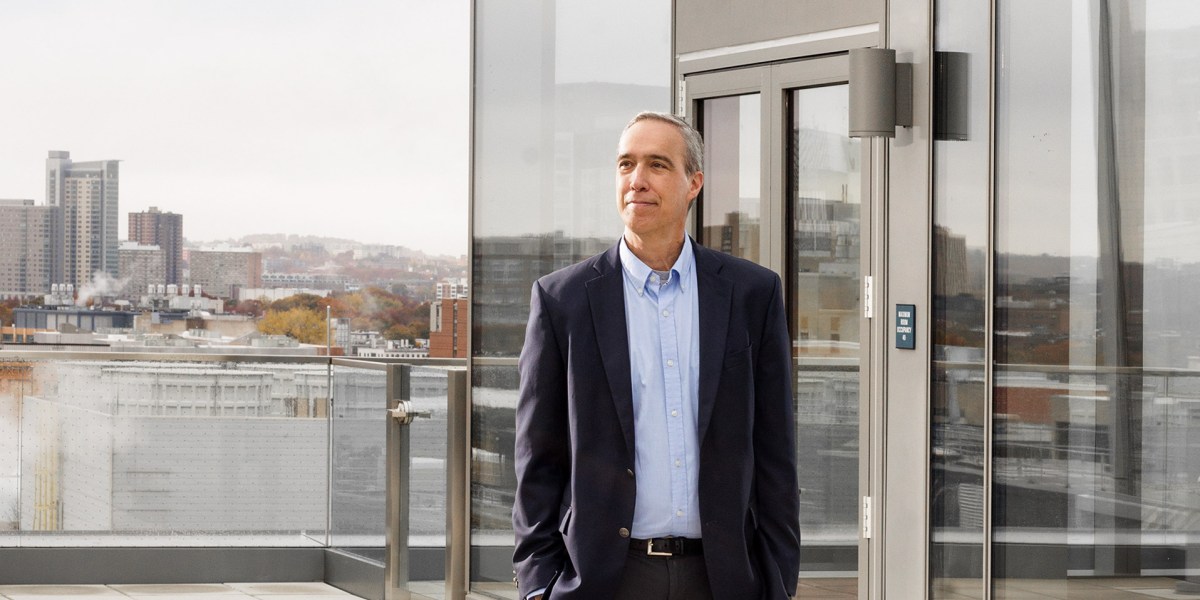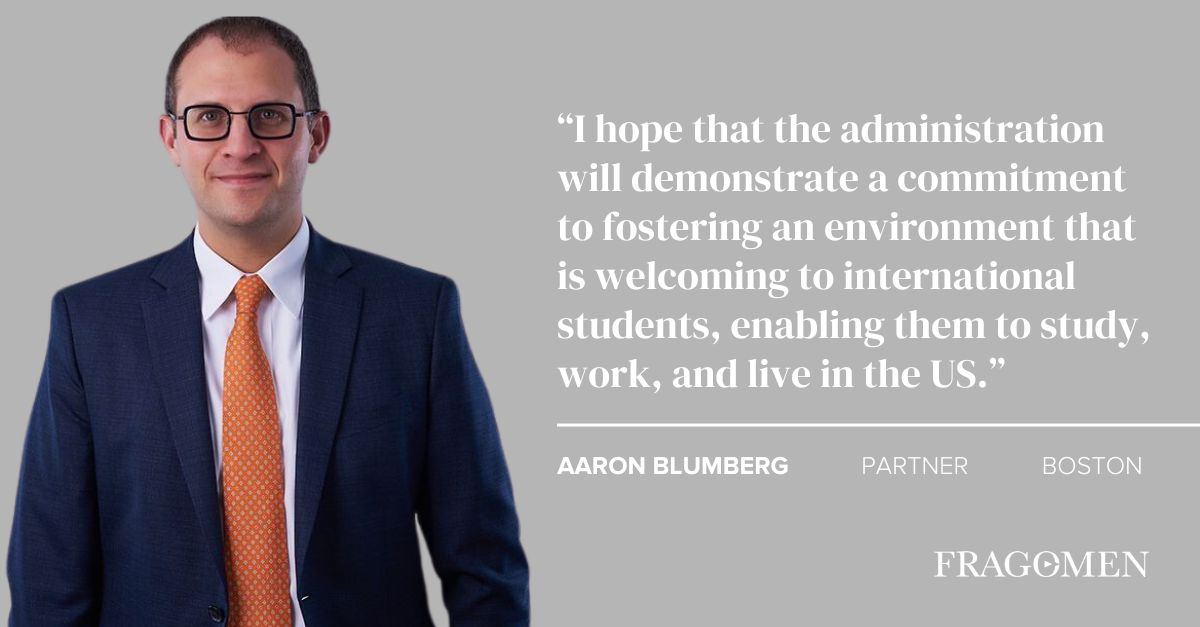
As machine learning and generative AI reshape the world, MIT’s Schwarzman College of Computing is integrating these and other advanced computing technologies into classrooms and labs across campus.
Dan Huttenlocher, SM ’84, PhD ’88, leads the way up to the eighth floor of Building 45, the recently completed headquarters of the MIT Schwarzman College of Computing. “There’s an amazing view of the Great Dome here,” he says, pointing out a panoramic view of campus and the Boston skyline beyond. The floor features a high-end event space with an outdoor terrace and room for nearly 350 people. But it also serves an additional purpose—luring people into the building, which opened last January. The event space “wasn’t in the original building plan,” says Huttenlocher, Schwarzman’s inaugural dean, “but the point of the building is to be a nexus, bringing people across campus together.”
Launched in 2019–’20, Schwarzman is MIT’s only college, so called because it cuts across the Institute’s five schools in a new effort to integrate advanced computing and artificial intelligence into all areas of study. “We want to do two things: ensure that MIT stays at the forefront of computer science, AI research, and education,” Huttenlocher says, “and infuse the forefront of computing into disciplines across MIT.” He adds that safety and ethical considerations are also critical.
To that end, the college now encompasses multiple existing labs and centers, including the Computer Science and Artificial Intelligence Laboratory (CSAIL), and multiple academic units, including the Department of Electrical Engineering and Computer Science. (EECS—which was reorganized into the overlapping subunits of electrical engineering, computer science, and artificial intelligence and decision-making—is now part of both the college and the School of Engineering.) At the same time, the college has embarked on a plan to hire 50 new faculty members, half of whom will have shared appointments in other departments across all five schools to create a true Institute-wide entity. Those faculty members—two-thirds of whom have already been hired—will conduct research at the boundaries of advanced computing and AI.
“We want to do two things: ensure that MIT stays at the forefront of computer science, AI research, and education and infuse the forefront of computing into disciplines across MIT.”
The new faculty members have already begun helping the college respond to an undeniable reality facing many students: They’ve been overwhelmingly drawn to advanced computing tools, yet computer science classes are often too technical for nonmajors who want to apply those tools in other disciplines. And for students in other majors, it can be tricky to fit computer science classes into their schedules.
Meanwhile, the appetite for computer science education is so great that nearly half of MIT’s undergraduates major in EECS, voting with their feet about the importance of computing. Graduate-level classes on deep learning and machine vision are among the largest on campus, with over 500 students each. And a blended major in cognition and computing has almost four times as many enrollees as brain and cognitive sciences.
“We’ve been calling these students ‘computing bilinguals,’” Huttenlocher says, and the college aims to make sure that MIT students, whatever their field, are fluent in the language of computing. “As we change the landscape,” he says, “it’s not about seeing computing as a tool in service of a particular discipline, or a discipline in the service of computing, but asking: How can we bring these things together to forge something new?”
The college has been the hub of this experiment, sponsoring over a dozen new courses that integrate computing with other disciplines, and it provides a variety of spaces that bring people together for conversations about the future of computing at MIT.
More than just a nexus for computing on campus, the college has also positioned itself as a broad-based leader on AI, presenting policy briefs to Congress and the White House about how to manage the pressing ethical and political concerns raised by the rapidly evolving technology.
“Right now, digital technologies are changing every aspect of our lives with breakneck speed,” says Asu Ozdaglar, SM ’98, PhD ’03, EECS department head and Schwarzman’s deputy dean of academics. “The college is MIT’s response to the ongoing digital transformation of our society.”
Huttenlocher, who also holds the title of Henry Ellis Warren (1894) Professor of Electrical Engineering and Computer Science and coauthored the book The Age of AI: And Our Human Future with Henry Kissinger and Eric Schmidt, has long been exploring such issues. He started programming computers back in middle school in Connecticut in the 1970s on an ASR 33 teletype machine, and eventually he studied at the University of Michigan as a double major in cognitive psychology and computer science, exploring speech recognition and visual perception. “AI work back then was relatively disconnected from the physical world,” he says. “Being interested in the perceptual side of things was kind of an outlier for what was going on in AI then.” When he looked at grad schools in the 1980s, only MIT, Carnegie Mellon, and Stanford were doing significant work in AI, he says: “I applied to those three schools and figured if it didn’t work out, I’d get a job.”
It worked out, of course. He headed to Cambridge and gravitated to MIT’s AI Lab in Technology Square, where he first worked on speech recognition and then transitioned into computer vision, at the time still in its infancy. After earning his PhD, he served simultaneously as a computer science professor at Cornell and a researcher at Xerox PARC, flying between New York and the burgeoning Silicon Valley, where he worked on computer vision for the digital transformation of copiers and scanners. “In academia, you have more curiosity-driven research projects, where in the corporate world you have the opportunity to build things people will actually use,” he says. “I’ve spent my career moving back and forth between them.”
Along the way, Huttenlocher gained administrative experience as well. He was a longtime board member and eventual chair of the MacArthur Foundation, and he also helped launch Cornell Tech, the university’s New York City–based graduate school for business, law, and technology, serving as its first dean and vice provost. When Stephen Schwarzman, CEO of the investment firm Blackstone Group, gave $350 million to MIT to establish a college of computing in 2018, he was eager to return to the Institute to lead it. “The fact that MIT was making a bold commitment to become a broad-based leader in the AI-driven age—and that it was cutting across all of its schools—was exciting,” he says.
Schwarzman College took shape through task forces involving more than 100 MIT faculty members. By the fall of 2019 a plan had been nailed down, and Huttenlocher was in place as director with EECS head Ozdaglar named deputy dean of academics. “I never believed that everybody wants to do computer science at MIT,” she says. “Students come in with a lot of passions, and it’s our responsibility to educate these bilinguals, so they are fluent in their own discipline but also able to use these advanced frontiers of computing.”
Ozdaglar’s background is in using machine learning to optimize communications, transportation, and control systems. Recently she has become interested in applying machine-learning algorithms to social media, examining how the choices people make when sharing content affect the information—and misinformation—recommended to them. This work builds on her longstanding interdisciplinary collaborations in the social sciences, including collaborations with her husband, economics professor (and recent Nobel laureate) Daron Acemoglu. “I strongly feel that to really address the important questions in society, these old department or disciplinary silos aren’t adequate anymore,” she says. “The college has enabled me to work much more broadly across MIT and share all that I’ve learned.”
Ozdaglar has been a driving force behind faculty hiring for the college, working with 18 departments to bring on dozens of scholars at the forefront of computing. In some ways, she says, it’s been a challenge to integrate the new hires into existing disciplines. “We have to keep teaching what we’ve been teaching for tens or hundreds of years, so change is hard and slow,” she says. But she has also noticed a palpable excitement about the new tools. Already, the college has brought in more than 30 new faculty members in four broad areas: climate and computing; human and natural intelligence; humanistic and social sciences; and AI for scientific discovery. In each case, they receive an academic home in another department, as well as an appointment, and often lab space, within the college.
That commitment to interdisciplinary work has been built into every aspect of the new headquarters. “Most buildings at MIT come across as feeling pretty monolithic,” Huttenlocher says as he leads the way along brightly lit hallways and common spaces with large walls of glass looking out onto Vassar Street. “We wanted to make this feel as open and accessible as possible.” While the Institute’s high-end computing takes place mostly at a massive computing center in Holyoke, about 90 miles away in Western Massachusetts, the building is honeycombed with labs and communal workspaces, all made light and airy with glass and natural blond wood. Along the halls, open doorways offer enticing glimpses of such things as a giant robot hanging from a ceiling amid a tangle of wires.
Lab and office space for faculty research groups working on related problems—who might be from, say, CSAIL and LIDS—is interspersed on the same floor to encourage interaction and collaboration. “It’s great because it builds connections across labs,” Huttenlocher says. “Even the conference room does not belong to either the lab or the college, so people actually have to collaborate to use it.” Another dedicated space is available six months at a time, by application, for special collaborative projects. The first group to use it, last spring, focused on bringing computation to the climate challenge. To make sure undergrads use the building too, there’s a classroom and a 250-seat lecture hall, which now hosts classic Course 6 classes (such as Intro to Machine Learning) as well as new multidiscipline classes. A soaring central lobby lined with comfortable booths and modular furniture is ready-made for study sessions.
For some of the new faculty, working at the college is a welcome change from previous academic experiences in which they often felt caught between disciplines. “The intersection of climate sustainability and AI was nascent when I started my PhD in 2015,” says Sherrie Wang, an assistant professor with a shared appointment in mechanical engineering and the Institute for Data, Systems, and Society, who is principal investigator of the Earth Intelligence Lab. When she hit the job market in 2022, it still wasn’t clear which department she’d be in. Now a part of Schwarzman’s climate cluster, she says her work uses machine learning to analyze satellite data, examining crop distribution and agricultural practices across the world. “It’s great to have a cohort of people who have similar philosophical motivations in applying these tools to real-world problems,” she says. “At the same time, we’re pushing the tools forward as well.”
Among other researchers, she plans to collaborate with Sara Beery, a CSAIL professor who analyzes vast troves of visual, auditory, and other data from a diverse range of sensors around the world to better understand how climate change is affecting distribution of species. “AI can be successful in helping human experts efficiently process terabytes and petabytes of data so they can make informed management decisions in real time rather than five years later,” says Beery, who was drawn to the college’s unique hybrid nature. “We need a new generation of researchers that frame their work by bringing different types of knowledge together. At Schwarzman, there is a clear vision that this type of work is going to be necessary to solve these big, essential problems.”
Beery is now working to develop a class in machine learning and sustainability with two other new faculty members in the climate cluster: Abigail Bodner, an assistant professor in EECS and Earth, Atmospheric, and Planetary Sciences (whose work uses AI to analyze fluid dynamics), and Priya Donti, assistant professor in EECS and LIDS (who uses AI and computing to optimize integration of renewable energy into power grids). “There’s already a core course on AI and machine learning—an on-ramp for people without prior exposure who want to gain those fundamentals,” says Donti. “The new class would be for those who want to study advanced AI/ML topics within the context of sustainability-related disciplines, including power systems, biodiversity, and climate science.”
The class on machine learning and sustainability would be part of Common Ground for Computer Education, an initiative cochaired by Ozdaglar and involving several dozen faculty members across MIT to develop new classes integrating advanced computing with other disciplines. So far, says Ozdaglar, it has generated more than a dozen new courses. One machine-learning class developed with input from nine departments provides exposure to a variety of practical applications for AI algorithms. Another collaboration, between computer science and urban studies, uses data visualization to address housing issues and other societal challenges.
Julia Schneider ’26, a double major in AI and mathematics, took the Common Ground class on optimization methods, which she says demonstrated how computer science concepts like shortest-path algorithms and reinforcement learning could be applied in other areas, such as economics and business analytics. She adds that she values such classes because they blend her two areas of study and highlight multidisciplinary opportunities.
“Even faculty who are leading researchers in this area say ‘I can’t read fast enough to keep up with what’s going on.’”
Natasha Hirt ’23, MEng ’23, came to MIT thinking that computer science was peripheral to her major in architecture and urban planning. Then she took a course with building technology professor Caitlin Mueller on structural optimization and design—and it changed the trajectory of her MIT career. That led her to Interactive Data Visualization and Society, a Common Ground class, and several interdisciplinary classes combining computer science and field-specific knowledge. She says these provided the perfect introduction to algorithms without delving too much into math or coding,giving her enough working knowledge to set up models correctly and understand how things can go wrong. “They are teaching you what an engine is, what it looks like, and how it works without actually requiring you to know how to build an engine from scratch,” she says, though she adds that the classes also gave her the opportunity to tinker with the engine.
She’s now working on master’s degrees in both building technology and computation science and engineering, focusing on making buildings more sustainable by using computational tools to design novel, less material-intensive structures. She says that Common Ground facilitates an environment where students don’t have to be computer science majors to learn the computational skills they need to succeed in their fields.
And that’s the intent. “My hope is that this new way of thinking and these educational innovations will have an impact both nationally and globally,” Ozdaglar says.
The same goes for recent papers MIT has commissioned, both on AI and public policy and on applications of generative AI. As generative AI has spread through many realms of society, it has become an ethical minefield, giving rise to problems from intellectual-property theft to deepfakes. “The likely consequence has been to both over- and under-regulate AI, because the understanding isn’t there,” Huttenlocher says. But the technology has developed so rapidly it’s been nearly impossible for policymakers to keep up. “Even faculty who are leading researchers in this area say ‘I can’t read fast enough to keep up with what’s going on,’” Huttenlocher says, “so that heightens the challenge—and the need.”
The college has responded by engaging faculty at the cutting edge of their disciplines to issue policy briefs for government leaders. First was a general framework written in the fall of 2023 by Huttenlocher, Ozdaglar, and the head of MIT’s DC office, David Goldston, with input from more than a dozen MIT faculty members. The brief spells out essential tasks for helping the US maintain its AI leadership, as well as crucial considerations for regulation. The college followed that up with a policy brief by EECS faculty specifically focusing on large language models such as ChatGPT. Others dealt with AI’s impact on the workforce, the effectiveness of labeling AI content, and AI in education. Along with the written documents, faculty have briefed congressional committees and federal agencies in person to get the information directly into the hands of policymakers. “The question has been ‘How do we take MIT’s specific academic knowledge and put it into a form that’s accessible?’” Huttenlocher says.
On a parallel track, in July of 2023 President Sally Kornbluth and Provost Cynthia Barnhart, SM ’86, PhD ’88, issued a call for papers by MIT faculty and researchers to “articulate effective road maps, policy recommendations, and calls for action across the broad domain of generative AI.” Huttenlocher and Ozdaglar played a key role in evaluating the 75 proposals that came in. Ultimately, 27 proposals—exploring the implications of generative AI for such areas as financial advice, music discovery, and sustainability—were selected from interdisciplinary teams of authors representing all five schools. Each of the 27 teams received between $50,000 and $70,000 in seed funds to research and write 10-page impact papers, which were due by December 2023.
Given the enthusiastic response, MIT sent out another call in the fall of 2023, resulting in an additional 53 proposals, with 16 selected in March, on topics including visual art, drug discovery, and privacy. As with the policy briefs, Huttenlocher says, “we are trying to provide the fresher information an active researcher in the field would have, presented in a way that a broader audience can understand.”
Even in the short time the college has been active, Huttenlocher and Ozdaglar have begun to see its effects. “We’re seeing departments starting to change some of the ways they are hiring around degree programs because of interactions with the college,” Huttenlocher says. “There is such a huge acceleration of AI in the world—it’s getting them to think with some urgency in doing this.” Whether through faculty hiring, new courses, policy papers, or just the existence of a space for high-level discussions about computing that had no natural home before, Huttenlocher says, the college hopes to invite the MIT community into a deeper discussion of how AI and other advanced computing tools can augment academic activities around campus. MIT has long been a leader in the development of AI, and for many years it has continued to innovate at the cutting edge of the field. With the college’s leadership, the Institute is in a position to continue innovating and to guide the future of the technology more broadly. “The next step,” says Ozdaglar, “is to take that impact out into the world.”
This story was part of our January/February 2025 issue.
A two-hour interview is enough to accurately capture your values and preferences, according to new research from Stanford and Google DeepMind.
The game was created from clips and keyboard inputs alone, as a demo for real-time interactive video generation.
Rapid advances in applying artificial intelligence to simulations in physics and chemistry have some people questioning whether we will even need quantum computers at all.
Vertical farms, woke AI, and 23andMe made our annual list of failed tech.
Discover special offers, top stories, upcoming events, and more.
Thank you for submitting your email!
It looks like something went wrong.
We’re having trouble saving your preferences. Try refreshing this page and updating them one more time. If you continue to get this message, reach out to us at customer-service@technologyreview.com with a list of newsletters you’d like to receive.
© 2024 MIT Technology Review












